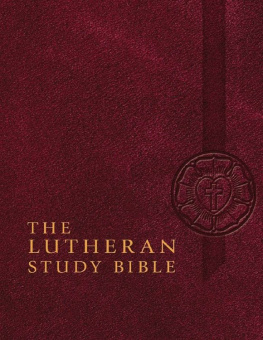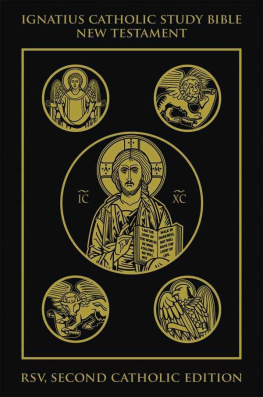Preface
In providing both undergraduate and postgraduateeducation, and in the research it carries out, a university is ultimately aninstitution at the service of society. It was with this service in mind thatthe theology faculty of the University of Navarre embarked on the project ofpreparing a translation and commentary of the Bible accessible to a widereadershipa project entrusted to it by the apostolic zeal of the University'sfounder and first chancellor, Monsignor Josemara Escriv de Balaguer.
Monsignor Escriv didnot live to see the publication of the first volume, the Gospel according to StMatthew; but he must, from heaven, continue to bless and promote our work, forthe volumes, the first of which appeared in 1976, have been well received andwidely read.
This edition of theBible avoids many scholarly questions, discussion of which would over-extendthe text and would be of no assistance to the immense majority of readers;these questions are avoided, but they have been taken into account.
The Spanish editioncontains a new Spanish translation made from the original texts, always takingnote of the Church's official Latin text, which is now that of the New Vulgate,a revision of the venerable Latin Vulgate of St Jerome: on 25 April 1979 PopeJohn Paul II, by the Apostolic Constitution Scripturarumthesaurus, promulgated the editio typicaprior of the New Vulgate as the new official text; the editio typica altera, issued in 1986, is the Latinversion used in this edition. For the English edition of this book we considerourselves fortunate in having the Revised Standard Version as the translationof Scripture and wish to record our appreciation for permission to use thattext, an integral part of which are the RSV notes, which are indicated bysuperior letters.
The introductions andnotes have been prepared on the basis of the same criteria. In the notes (whichare the most characteristic feature of this Bible, at least in its Englishversion), along with scriptural and ascetical explanations we have sought tooffer a general exposition of Christian doctrinenot of course a systematicexposition, for we follow the thread of the scriptural text. We have also triedto explain and connect certain biblical passages by reference to others,conscious that Sacred Scripture is ultimately one single entity; but, to avoidtiring the reader, most of the cross-references aregiven in the form of marginal notes (the marginal notes in this edition are,then, those of the Navarre Bible, not the RSV). The commentaries contained inthe notes are the result of looking up thousands of sources (sometimesreflected in explicit references given in our text)documents of theMagisterium, exegesis by Fathers and Doctors of the Church, works by importantspiritual writers (usually saints, of every period) and writings of the founderof our University. It would have been impertinent of us to comment on the HolyBible using our own expertise alone. Besides, a basic principle of exegesis isthat Scripture should be inter - preted in the contextof Sacred Tradition and under the guidance of the Magisterium.
From the very beginningof our work our system has been to entrust each volume to a committee whichthen works as a team. However, the general editor of this edition takesultimate responsibility for what it contains.
It is our pleasant dutyto express our gratitude to the present chancellor of the University ofNavarre, Bishop Alvaro del Portillo y Diez de Sollano,for his continued support and encouragement, and for reminding us of the goodour work can do for the Church and for souls.
"Since SacredScripture must be read and interpreted with its divine authorship inmind," we pray to the Holy Spirit to help us in our work and to help ourreaders derive spiritual benefit from it. We also pray to Mary, our Mother,Seat of Wisdom, and St Joseph, our Father and Lord, to intercede that thissowing of the Word of God may produce holiness of life in the souls of manyChristians.
The Captivity Epistles
From very early on it has been customary todistinguish four of St Paul's lettersEphesians, Colossians, Philippians andPhilemonas the "Captivity Epistles" because they were written whenthe Apostle was in prison (cf. Phil 1:7, 12-17; Eph 3:1; 4:1; 6:20; Col 4:3,10, 18; Philem 9, 13,23).
Given that St Paulsuffered imprisonment in Ephesus, Caesarea and Rome, we do not know for certainwhether these letters were all written from the same place. The most common andbest argued opinion has it that he wrote Colossians, Ephesians and Philemon inRome during his first imprisonment there (in the years 61-63), and, to be moreprecise, towards the end of that period, given that in Philemon 22 he refers tohis hope of an early release. As regards Philippians, some scholars argue infavour of its having been written in Ephesus (cf. 1 Cor 15:30-32; 2 Cor 1:8-10)on the grounds that this better explains the Apostle's relationships with thefaithful at Philippi.
Whichever of thesetheories is correct, Philippians was written before Colossians and Ephesians;and Ephesians came shortly after Colossians, dealing with the same themes in amore elaborate way. The Letter to Philemon, although written during the sameperiod as the others, is of quite a different type, being a short note aboutthe return of a runaway slave.
In spite of thechronology we have just described, in the present edition of the CaptivityEpistles we follow the traditional order in which they appeared in the Vulgateand which the New Vulgate has maintained, namely, Ephesians, Philippians,Colossians and Philemon.
In the introductions tothe individual letters we discuss the arguments in favour of Paulineauthorship, as also the structure of each letter. Here it is sufficient topoint out that tradition is unanimous and explicit in identifying all of themas written by St Paul; St Justin, to name just one source, gives Paul as theirauthor.
As regards the contentof the letters, two factors should be borne in mind in order to situate andunderstand them, particularly Colossians and Ephesians. The first is that StPaul is dealing with new problems caused, apparently, by views imbued with acertain Gnosticism, that is, an excessive desire for arcane, salvation-bringing"wisdom", and a readiness to reduce the absolute primacy of Christ tothe level of other forces or "powers" regarded as salvific. Thesecond feature of these epistles is the fact that as time goes on and theChurch develops, the Apostle is delving deeper and deeper into the mystery ofChrist and the Church, discovering, with the help of the Holy Spirit, aspectswhich were only barely discernible in earlier letters.
The Canon of Scripture
THENOTION OF CANON
The word "canon" comes from kanon, a Greek term which, some scholars think, derivesfrom the Semite word qaneh. It originally meant arod or reed but it was also used as a measure of length. Hence its meaning of measure or rule, that is, a norm or standardof behaviour or speech. It can be applied to ethics, art or literature: forexample, people speak of the "canon" of music or of architecture. Itis also used in the sense of index, list or catalogue. St Paul uses it in thesense of rule of conduct when he says in Galatians 6:16: "Peace and mercybe upon all who walk by this rule [ kanon ]".
The term"canon" was used in the Church from the beginning to refer to therule of tradition, the way to identify the content of Revelation. For manycenturies past the word has also been applied to rules or principles emanatingfrom the highest authority of the Churchdoctrinal canons issued by Councils,or legal canons, as in the Code of Church Law, the Code of "Canon"Law.
Sacred Scripture hasalways been regarded as containing a rule or standard of faith and morals forall Christians. And so, from very early on, the inspired books as a whole beganto be described as the "canon" because they contain the basic normsof faith and morals. Later, from the fourth century approximately, the list ofsacred books began to be called the "biblical canon" or "canonof the Bible".













